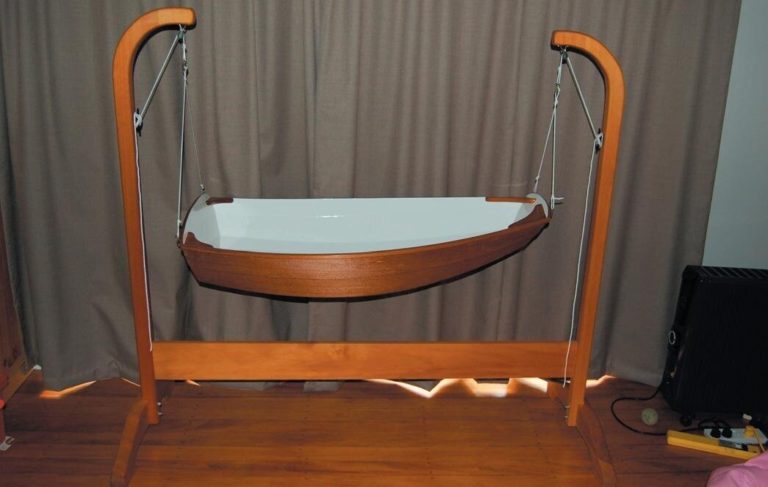By Andrew Wells
A pretty simple water rocket launcher using a few high-pressure PVC plumbing pipes, air and a soft-drink bottle with water in it will provide plenty of DIY fun and show some basic physics.
I built one for my eight-year-old’s Cub Scout group and have had lots of requests from fathers asking how to make one.
A bottle with a little water in it is placed upside down on a pipe. Air is forced through the pipe and into the bottle which, under pressure, will fly as much as 50 metres into the air.
The physics principle is the same as that for rockets – equal and opposite forces. The rocket goes up because there is a mass of water being forced downwards by the air pressure inside the bottle. The weight of the water under pressure creates more force than the similar volume of air under pressure which would not result in the same height of flight.
Generally, PET (Polyethylene terephthalate) soft drink bottles will reliably sustain pressures of 140psi. We only use up to 110psi in our rig and have never had a problem. We can do launches at 80psi.
For safety, the pipes (from builder supply stores) should be “high pressure” rather than “drainage” pipes but this is clearly stated on the pipe itself.
Drill a concentric hole in an end cap. Glue a bike valve trimmed from an inner tube into the end cap from the inside, using plenty of 24-hour Super Strength Araldite or other epoxy adhesive. An ordinary glue will not hold under pressure. Set aside to cure.
View fullsize
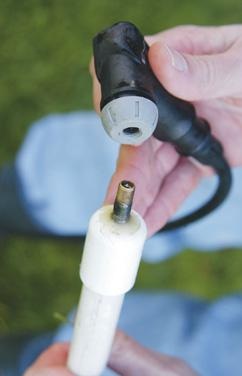
View fullsize
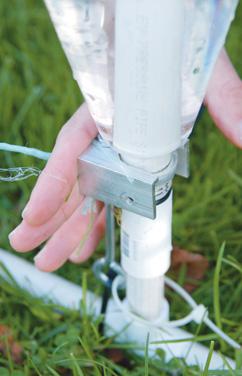
PIPEWORK
From 2m of 15mm pressure pipe cut six pieces:
• P1 Cut only as long as required to connect the high-pressure joiner to high-pressure junction T1.
• P2 Should be just shorter than the smallest bottle that you want to use. At 150mm long, P2 can fi t all 350ml and larger bottles. A longer pipe will give better launches.
• P3A / P3B These are just for stability, so any length more than about 200mm will do.
• P4 Length not critical.
• P5 Make this long enough so that the person who is pumping is well away from the bottle during pumping. We made ours about 800mm. Using the recommended solvent, assemble.
The joiner between P1 and P2 creates the lip on which the 15mm inside-diameter O-ring sits to create the seal. Without the extra height of this joiner, there is not enough room to fi t the clamp (i.e. if you tried to have a single pipe rising from T1). Leave the assembly to cure. Slide the O-ring onto the launch post.
View fullsize
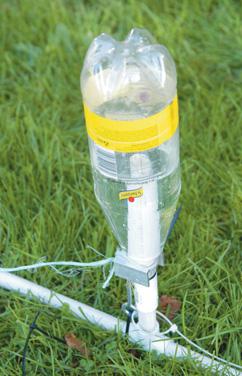
View fullsize
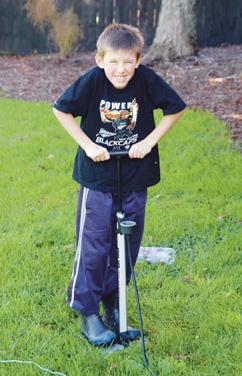
CLAMP
For a clamp to hold the bottle down until launch, from a scrap piece of metal cut a slot 27mm wide. It should clear the neck but not let the flange of the bottle through. Drill a hole for an eye bolt approx 100mm long. Fit with two nuts. Tie the eye of the bolt around the horizontal pipe with a cable tie, leaving it loose enough to swing. To adjust, fi t a soft drink bottle and move the nuts until the clamp fi ts snugly around the neck, but can still be pulled off. Lock-off the two nuts.
View fullsize
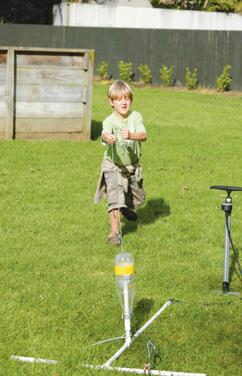
LAUNCHING
Half-fill a bottle with water and slip it down over the launch tube against the O-ring. Slide on the clamp to hold the end of the bottle against the O-ring. Make sure everyone is well clear from above the bottle. Pump air into the valve, up to about 80psi to start with. To launch, pull the clamp off (with a length of string or the launcher gets pretty wet).
With a compressor, the fi ll is almost instant as there is very little volume within the pipes and bottle. With a bike pump it takes 15-20 seconds of vigorous pumping to get up to 100psi.
Lift off. Eight-year-olds Marshall and Finn launch the water rocket. Dad watched from the wings



